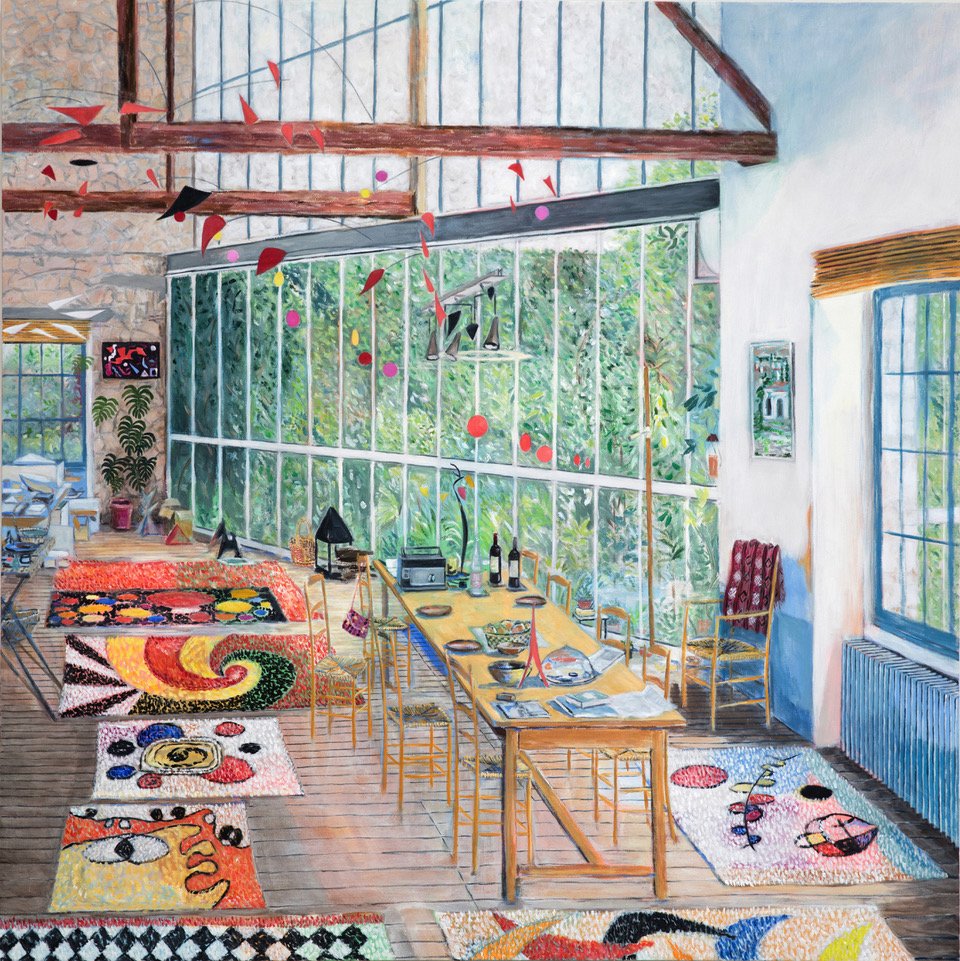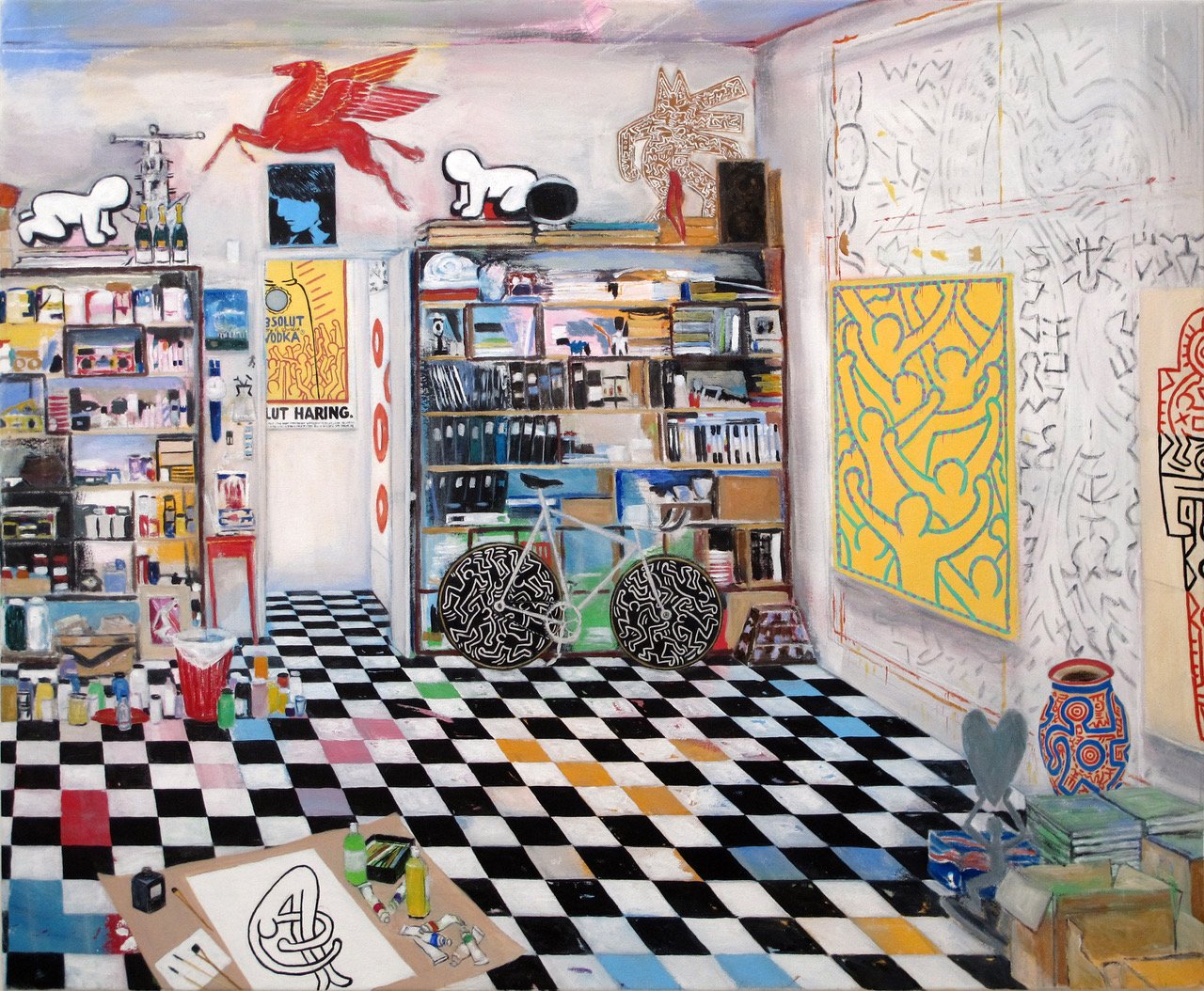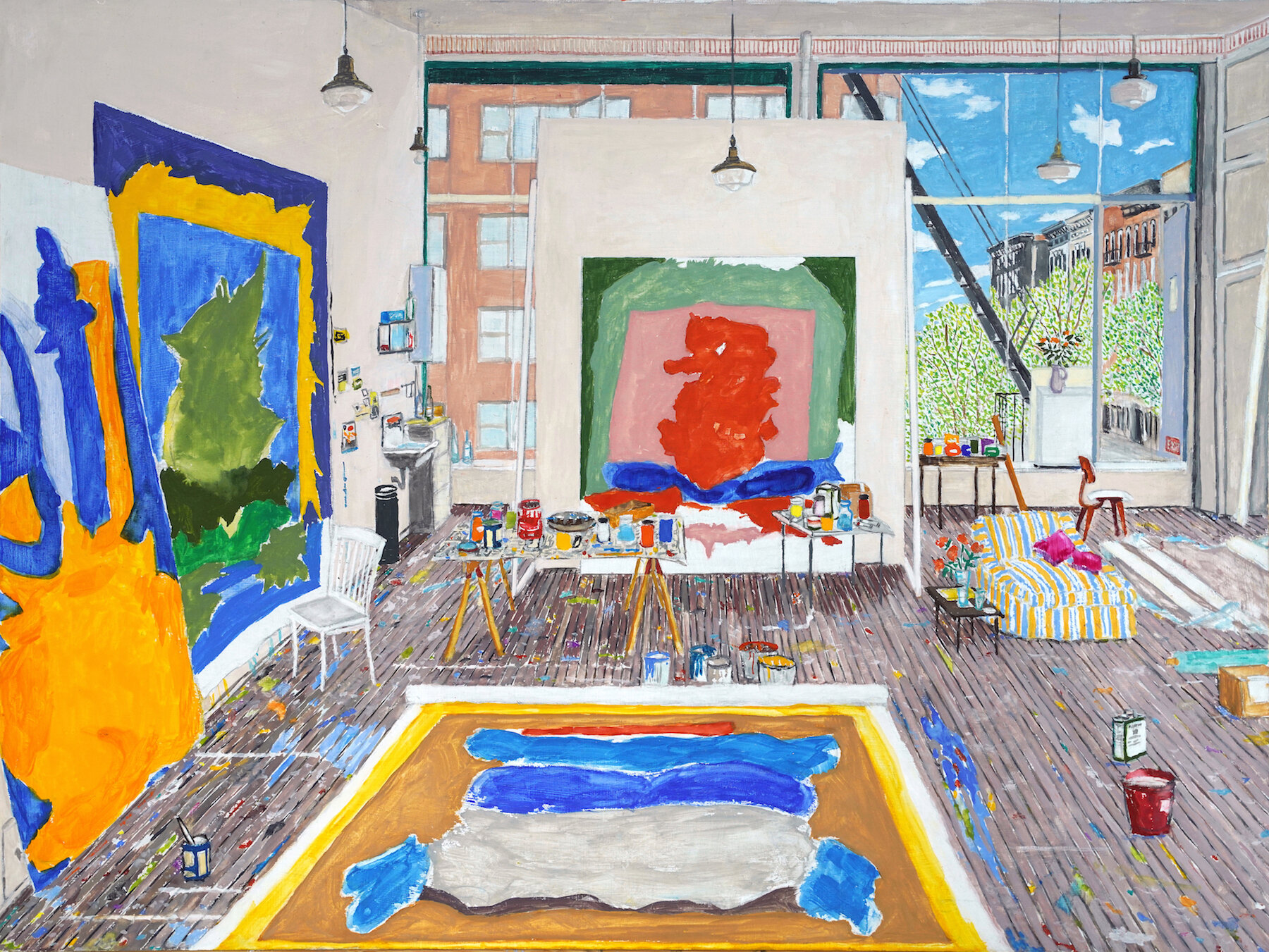ABOUT
“Elwes paintings are a mystical, magical tour of rarely seen wonderlands.”
Six artist studios and the ground floor of Picasso’s Villa in Cannes
“Excellent artist...It is Contemporary because no one else has done this before.”
VOGUE PORTUGUAL - APRIL 2024
“Elwes spends weeks, even months researching the exact physical details of a scene he is concerned with.”
“This entails deep research, interviewing people who knew the artists, and personal visits to the studios - though many are no longer actual places of art-making. Therein lies the detective work.”
“He is mapping the mental and creative landscape of an artist.”
KEITH HARING’S STUDIO WITH BIKE< acrylic on canvas, 59, 65in, 2010
“I just know you are a painter. I can tell. Once you make one painting you won’t be able to stop.”
“Instead of going to art school I went to Paris for two years and made a painting of a different artist studio each day.”
“Elwes paints his way into the spirits of his subjects.”
MIRO’S STUDIO IN MALLORCA, ACRYLIC ON CANVAS, 60 X 70in/152.4 x 177.8cm, 2022
“I can tell that you are going to be a very good painter because of the way you use the color yellow.”
“Living with a Damian Elwes painting is pure joy. When you see it in the morning, it makes your whole day.”
Damian’s next show July 2024 Unit London, 3 Hanover Square, London W1
SELECTED EXHIBITIONS:
2024 Unit London (solo) 2023 Seojung Gallery, Seoul, S.Korea 2022 Nassima Landau Foundation, Tel Aviv 2021 “Art and Hope,” USC Fisher Museum, L.A. 2020 “The Room Where It Happened” Unit London (solo) 2019 “In the Studio, Creation at Work” Musée Eugène-Delacroix/Louvre, Paris 2019 “Artist Studios: From Klimt to Kusama” Modernism, San Francisco (solo) 2018 “Independent Vision” Arkansas Arts Center 2018 “Secrets of the Studio, Monet to Wei Wei” Museé en Herbe, Paris (solo) 2016 “Artist Studios from Giacometti to Kapoor” Serena Morton, London (solo) 2016 “Artist Studios from Picasso to Jeff Koons” Modernism, San Francisco (solo) 2015 “Staring Back on Picasso’s Demoiselles d’Avignon” Fleming Museum of Art, VT 2015 “Spark” El Segundo Museum of Art, CA 2010 “The Art of Knowledge” Zimmer Museum of Art, L.A. 2008 “Creative Spaces: The Studios of Dali, Kahlo, Picasso, Matisse” Lefevre, London (solo) 2007 “Artists’ Studios” Scream, London (solo) 2007 “The Demoiselles Revisited” Francis Naumann, NYC 2006 “Picasso’s Villa La Californie” curated by Fred Hoffman, M&B Fine Arts, L.A. (solo) 2004 “The Studios of Matisse, Picasso, Warhol, and Duchamp” Francis Naumann, NY (solo) 1999 “Amazon” Robert Berman, L.A. (solo) 1998 “Forest of Statues” + “Fallen Tree” Richard Salmon Gallery, London (solo) 1992 “Byron Keats and Shelley in Italy” Earl McGrath Gallery, L.A. (solo) 1991 “Cartagena” Caz Gallery, Los Angeles (solo) 1984 “Jean Michel Basquiat + Graffiti Art” curated by Robert Fraser, Fruitmarket Gallery, Edinburgh
MAGAZINE ARTICLES:
BRITISH VOGUE visits Damian’s Colombian Studio



“That’s the best F***ing article I’ve ever seen in a magazine........You must have balls of steel.”
WHITE HOT MAGAZINE, NEW YORK CITY
FEBRUARY 2021
"THE BEST ART IN THE WORLD"
Pictures From a Pandemic: Damian Elwes
Hilma af Klint’s Studio, 2020, Gouache on board, 20.5 x 25.5 in. Courtesy of the artist.
By ANTHONY HADEN-GUEST
Damian Elwes’ father and grandfather were artists. “They both left me their brushes,” he says. But Elwes, a young Brit, went to Harvard, resolved to write plays. Graffiti was the game-changer. “The paintings on the walls of New York City were alive and metamorphosing every day,” he says. “This was 1984.”
After Harvard, the director, Sidney Lumet, hired him to work on a movie. “My job was crowd control,” Elwes says. One shoot was in Penn Station “I cleared everybody out. And there was Keith Haring, working on black posters with white chalk. I told him that what he was doing looked a lot more interesting than what I was doing.” He and Haring talked graffiti. “He was very approachable and magnanimous,” Elwes says. But Haring insisted that Elwes make a painting before they spoke again.
Elwes soon got another assignment. Lumet’s town house was to be replaced by a skyscraper, so he was out of the place and wanted Elwes to make sure his belongings were safely out too. Done deal. “Next day I realized I had the keys to a double brownstone on West 56th Street,” he says. “I’m so lucky! This is where I can do a painting. As a Brit I was too uncomfortable to go out on the street and paint graffiti, so I painted every day in that building.”
The building was huge, its flat roof was soon covered with Elwes graffiti and highly visible. Word got around and Robert Fraser, a leading London dealer, who was in New York putting together the first UK show about New York graffiti art, was told about this Brit practicioner. The gallerist was skeptical. “There’s no English graffiti artists. There’s no graffiti art in England!”. But he did send his assistant, Gerard Faggionato, to check it out, and he gave the work a thumbs up. “Robert loved my paintings,” Elwes says. A couple of months later Elwes was in the UK for the opening at a major Edinburgh gallery, the Fruitmarket.
Helen Frankenthaler’s Studio, 2020, Gouache on board, 18.4 x 25 inches. Courtesy of the artist.
Elwes then went down to London and met Jean-Michel Basquiat, at his retrospective at the ICA, in which Robert Fraser had a hand. Fraser offered Elwes a graffiti art show on Cork Street, but Elwes was already moving on from this. “I want to tell stories. You can’t tell stories with a spray can,” he told Fraser. “I’m going to go to Paris to learn to paint with a brush”.
Elwes spoke marginal French but hit the Paris pavement running. “On my first day I went to Picasso’s Bateau Lavoir studio,” he says. “And there was nothing there, it was gone. Next day I went to where Matisse had had a studio on the Quai St Michel. That building is still there, but I couldn’t get in past the concierge.” But at the Pompidou Center he chanced upon Picasso and Matisse paintings of their studios alongside each other. “I sat in front of those paintings for several hours. I was crying because I was realizing at that moment how much I loved painting. I loved line, form and color. I guess I was thinking about my grandfather and father being painters and that I was now painting. It was not something that I had really wanted to do. It had just happened.”
SPEARS MAGAZINE 2017
NYC Art Critic- Anthony Haden Guest







ELLE MAGAZINE 2018
Paris Museum Show
CRAVE 2016
NYC Art Critic- Miss Rosen




SF WEEKLY 2016
San Francisco Art Critic Jonathan Curiel


Picasso’s Villa La Californie
Los Angeles Art Historian Fred Hoffman, Curator of 2006 Basquiat Retrospective at Brooklyn Museum, MFA Houston + MOCA L.A.
Damian Elwes and the Modernist Heritage
By Fred Hoffman
Central to the Modernist Tradition has been the artist’s concern for the art that has preceded him. One cannot think of Manet without bringing to mind the paintings of Velasquez; one does not think of early Picasso without remembering the work of Cezanne, the Impressionists, and the Symbolists; and one cannot fully digest Roy Lichtenstein without considering his reflections on Monet, Kirchner, Marc, Picasso and the Surrealists.
Damian Elwes has taken this fundamental tenet of modernist practice even further. In focusing on the pictorial re-creation of different Modern painter’s studios, at specific, historically important moments, he has found the means to create a meaningful set of subjects for his own practice as a painter.
While we, the viewer are immediately intrigued and invited to partake of these historical moments, what actually sustains, even heightens our interest, is Damian Elwes’ ability to turn documentation and historical record into compelling pictorial visions requiring repeated viewing and constant deciphering. While we sense that the “scene” unfolding before us is digestible as one clearly defined entity, these works result from a laborious build up, with constant revision and reconsideration of each detail, each piece of information contained within. What is especially interesting, even noteworthy, is that Elwes’ paintings are never the result of information contained in one photograph. Quite the contrary, Elwes spends weeks, even months researching the exact physical details of a scene he is concerned with. In so doing, he is constantly discovering new pieces of information—whether it be the precise layout of an artist’s easels, supplies, tables, chairs, etc.; or in many cases the particular paintings the artist would have had in his studio at any given moment in time.
Elwes’ concern for historical accuracy, and his subsequent investigative process enables his fully realized paintings to have a freshness and immediacy which none of the source material contains nor conveys. It is not, therefore, the fact that he has painted Picasso’s studio that makes Elwes’ work of interest. Rather, it is his ability to use the historical source material about Picasso to achieve some immediacy for his own concerns as a painter. In a way, turning to the practice of a previous artist, combined with intensive investigation and evaluation of that artist’s practice at a given moment in time, results in a great deal of artistic freedom for Elwes’ own practice. With this freedom he is able to express, with a great deal of conviction, even passion, his love for the underlying elements of great painting including composition, color and light. Firmly rooted in these fundamental concerns, Elwes is able to tap into the expressive potential for painting. In the end, it is the expressive quality of these works that we feel drawn to.
If my paintings seem uplifting it’s because I am focusing on Creativity which is the most positive force in the world. Damian Elwes












